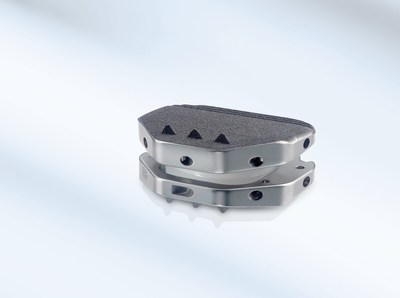CENTER VALLEY, Pa.,
Sept. 25, 2018 /PRNewswire/ --
Aesculap Implant Systems, LLC today announced that critical
long-term data will be presented by Dr. Scott Blumenthal of the Center for Disc
Replacement at the Texas Back Institute during the NASS 2018 Annual
Meeting (Los Angeles, CA,
September 25-29, 2018). The post-hoc
analysis from the activL® Artificial Disc
Investigational Device Exemption study challenges common
misconceptions about the value of motion preservation at the
lumbosacral junction. Two different oral podium presentations will
be delivered during the NASS Annual Meeting examining the effects
of range of motion on long-term clinical outcomes. This data comes
one year after NASS panelists concluded that the body of evidence
for lumbar total disc replacement (TDR) supports lumbar TDR as a
standard of care for the treatment of discogenic chronic low back
pain.

"When we began analyzing the data specific to the performance of
these disc replacements at L5/S1, it became obvious that there are
reasons to avoid a fusion, if possible, at this level," said
Scott Blumenthal, MD. "Patients who
had six degrees of motion at L5/S1 five years postoperative
experienced 100% success in their VAS pain score improvement and
for every two degrees of motion were more likely to have Oswestry
success. That says a lot about the correlation between motion, pain
and function and why we do what we do."
The long-term data will also report on the long-term range of
motion outcomes between first and current generation lumbar disc
replacement designs and its impact on clinical outcomes and
adjacent segment disease. On average, activL® Artificial
Disc patients maintain their preoperative range of motion (6.6° vs.
6.1°, p=0.4) while ProDisc-L patients do not (6.2° vs. 4.2°,
p=0.02). This drop off in range of motion has been correlated to
increased progression of adjacent segment disease (8.8% vs. 19%,
p=0.05).
Details of the NASS oral presentations:
Impact of Range of Motion on Patient Outcomes Five Years
Following Lumbar TDR at L5-S1
|
Session:
|
|
Abstract
Presentations: Preserving Spinal Motion
|
|
Date,
Time:
|
|
Wednesday, September
26, 4:29 – 4:35
|
|
Location:
|
|
Room 403B
|
|
Presenting
Author:
|
|
Scott L. Blumenthal,
MD, Richard D. Guyer, MD, Jack E. Zigler, MD and Donna D. Ohnmeiss,
PhD.
|
|
Institutions:
|
|
Texas Back Institute
and Texas Back Institute Research Foundation,
|
|
|
Plano,
Texas
|
Impact of Range of Motion on Progression of Adjacent Segment
Disease: Disc versus Disc
|
Session:
|
|
Section on Motion
Technology Abstract Presentations
|
|
Date,
Time:
|
|
Thursday, September
27, 4:44 - 4:50
|
|
Location:
|
|
Room 406AB
|
|
Presenting
Author:
|
|
Scott L. Blumenthal,
MD, Richard D. Guyer, MD, Jack E. Zigler, MD and Donna D. Ohnmeiss,
PhD.
|
|
Institutions:
|
|
Texas Back Institute
and Texas Back Institute Research Foundation,
|
|
|
Plano,
Texas
|
To learn more about the activL® Artificial Disc, please visit
Aesculap Implant Systems at Booth #1101 in the
NASS 2018 Exhibit Hall.
About Aesculap Implant Systems, LLC
Aesculap Implant
Systems, LLC, a B. Braun company, is part of a 175-year-old global
organization focused on meeting the needs of the changing
healthcare environment. Through close collaboration with its
customers, Aesculap Implant Systems develops advanced spine and
orthopaedic implant technologies to treat complex disorders of the
spine, hip and knee. Aesculap Implant Systems strives to deliver
products and services that improve the quality of patients' lives.
For more information, call 800-234-9179 or
visit aesculapimplantsystems.com.
 View original content to download
multimedia:http://www.prnewswire.com/news-releases/maintenance-of-motion-at-l5s1-does-matter-300718898.html
View original content to download
multimedia:http://www.prnewswire.com/news-releases/maintenance-of-motion-at-l5s1-does-matter-300718898.html
SOURCE Aesculap Implant Systems, LLC